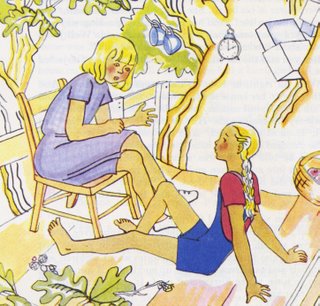
--and my first thought was: the author must be the illustrator (she was). I kind of like the drawings in this book – they’re just so bizarre. And I also always liked Arthur Ransome’s drawings for Swallows and Amazons, which was published in the 1930s, too. They’re charming and suit the books.
I’m guessing that these authors weren’t ever professional illustrators (girls, what do you think?). And do you think authors this amateurish could get away with illustrating their own chapter books today? I hope it’s possible, even if the illustrations aren’t up to Grace’s charming drawings in the equally charming Year of the Dog, it’s just FUN to find colorful illustrations like these scattered throughout a book, especially when the author is the illustrator:

The girl on the left is described as fat -- I’ve never seen the word “fat” mentioned so often in a book as it was in Thimble Summer. People were also described as “fleshy,” as when someone says, “They are one fleshy family.” I didn’t know people were that preoccupied with weight in the 1930s – or was it just this author? Pigs were mentioned a lot, too – one is described as “unusually greedy and selfish, even for a pig.” This isn’t a criticism, I enjoyed the book; I just found this sort of thing unusual:
“Garnet watched Mrs. Hauser [the mother in the “fleshy family”] get into the car. Did she imagine it, or did she really see the Ford sink down a little on its springs, as if it sighed under a great weight.”
That made me laugh, though I was half-relieved and half-disappointed to see that this character’s daughter, also described as “fat,” was the perfectly normal-looking girl with a bob above. Fuse8 worried in her review that children, seeing this, would think that THEY were fat and be troubled; I am not. I weigh a lot more than I once did and already think I'm fat. When I saw this picture, I was reassured. I thought, "Oh, fat doesn't look so bad." Maybe it really doesn't!

7 comments:
I *think* i read THIMBLE SUMMER as a kid, and I definitely don't remember all of those "fleshy" and "fat" references! Then again, I WAS preoccupied with my weight, but that's probably a combination of everything.
I think that's fascinating, though.
Ha ha! I was delighted to find that you located my old review of the book from a couple years ago. It's also nice to hear that kids would be relieved that the friend was "fat" since she didn't look it one little bit. Unless you compared her to that pigtailed waif at her side.
Still a great book. One of the great Newbery 3 (alongside "Roller Skates" and "Caddie Woodlawn").
Is it possible that this is what fat looked like during the Depression?
Linda Urban
Thanks, Alvina! Fuse: Well, I don't know about kids in general....*I* was relieved and am guessing that as a kid I wouldn't even have noticed the references (I wasn't preoccupied with my weight then). I loved your review -- I read it a few months ago, which is what alerted me to Thimble Summer, and then again after I had read the book. I had forgotten what you said about the weight thing -- I WAS struck by all the references fat, maybe because I am preoccupied with this topic! Maybe that's why I found the references so funny. Linda: interesting about the Depression. I wonder.
I look forward to reading ROLLER SKATES, which I've never heard of...
So what do people think about author illustrations?
I think the art is fine--charming and appropriate. They don't strike me as looking particularly amateurish. I'm curious what the artists or designers out there think.
I think that Elizabeth Enright's illustrations are charming and very much of their time. I'm not sure about her own art education but her mother was Maginel Wright Enright, a pretty prolific illustrator in the '20's and '30's-- she did a lot of illustrations in the Bookhouse series-- she was also the sister of Frank Lloyd Wright.
That's really interesting, Sarah -- thanks! Have you seen Maginel's illustrations? I'm going to look for them.
Post a Comment